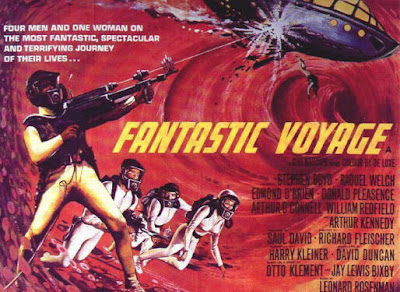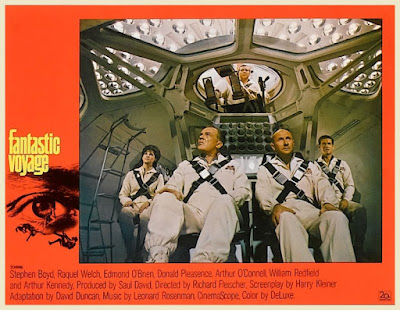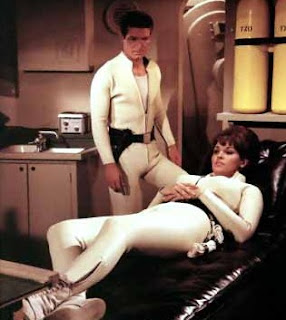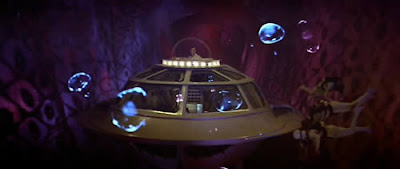Now, I was no goggle-eyed fan of Avatar, nor a teeth-clenched detractor. And 3-D so far feels like a marketing strategy that will go down better when its gloss fades and it's employed for more than its own sake. But I've been saying for years that Fantastic Voyage is ideal remake fodder with today's techniques, and, yeah, such a remake may justify the whole 3-D revival with the ideal marriage of technique and subject. I'm just surprised that it has taken this long for the green light to pop on.
 Cameron would be my "go to" producer for the project given his fondness for scale and scope, not to mention his (rare and welcome) scientific interests and propensities. Levy strikes me as a director capable of giving the otherworldly premise and trippy imagery a necessary realistic, you-are-there grounding.
Cameron would be my "go to" producer for the project given his fondness for scale and scope, not to mention his (rare and welcome) scientific interests and propensities. Levy strikes me as a director capable of giving the otherworldly premise and trippy imagery a necessary realistic, you-are-there grounding.For an easy dozen reasons the 1966 screenplay requires a start-to-finish contemporary upgrade, and Salerno may be an okay writer for the task, I don't know. (While, yes, Cameron does have a track record of short-shrifting the writing dimension in his movies, I'll hope for the best here. Still, AvP: Requiem, really? Mr. Cameron, sir, call me, please.)
[Update: It's reported that Cameron has signed up Laeta Kalogridis to write a new draft.]So this one has me jazzed, I have to say. Of course it helps that I hold a fondness for the original. Because of the remake news, I took a break yesterday to pull the DVD off the shelf and give it a nostalgic spin. And right off the bat, the DVD's audio commentary track — delivered by Jeff Bond, an editor of the late, lamented Cinefantastique/CFQ magazine (the Cahiers du cinéma for genre fanatics) — knows who this disc's most enthusiastic audience will be: "Like most of you," he begins, "I grew up watching this movie on television."
He's right. For a certain generation — the one that remembers entire years before Star Wars premiered and was content with merely one short-lived Star Trek series in reruns — TV in the 1970s meant scanning the weekend afternoon schedules across all four channels for a reliable repeat of some special-effects favorite: a Ray Harryhausen creature feature if we were really lucky, or some vintage War of the Worlds action.
High on the short list of faves was Fantastic Voyage, with its cool futuristic submarine miniaturized to microscopic size and pushed through the tip of a hypodermic needle into a human bloodstream. Instead of an unconvincing classroom illustration, our own human interior was revealed, like a Jacques Cousteau travelogue, in screen-filling vistas of surreal canals and chambers filled with floating psychedelia and the amorphous Jell-O colors of a Jimi Hendrix concert.
Here was a "smart" sci-fi adventure worth tuning in again and again. Where else could we pass through a cavernous human heart, see laser beams zap wall-sized brain tissue, fear attacks from giant white-blood-cell blob-monsters, or (especially) experience Raquel Welch needing someone to rip all those killer antibodies from her form-fitting white wetsuit? Everywhere, adolescent males such as yours truly justified repeated viewings of Fantastic Voyage as part of our necessary education in biology, although the nature of the arterio-venous fistula was just the cover story.
Played with steadfast seriousness, the straight-line story itself is just incidental. Strip away the sci-fi visuals and "reticular fibers" lingo, and what you have is a routine plot about a crack team of specialists brought together to beat the clock in a wartime commando raid. It's The Pons of Navarone, or The Spy Who Came in from the Acute Viral Nasopharyngitis.
The film begins as a taut, almost noirish, international Cold War thriller, all black sedans speeding through the night and an attempted assassination of a defecting scientist. (The enemies are only presumably Soviet bloc communists; they're identified simply as "the Other Side" in a way that makes you hear the capital letters.) The assassination fails, but the scientist is critically wounded, which is bad news for Our Side because only he knows the secret to prolonging miniaturization beyond 60 minutes.
The threatening blood clot in his brain is ill-suited for conventional surgery, so a special agent (square-jawed haircut Stephen Boyd) is recruited to join a crew assigned to enter the scientist's body aboard the subcellular cruiser Proteus. It's his job to keep a steely eye on the crew: the easy-going captain played by William Redfield, Donald Pleasence as twitchy Dr. Michaels, and Ms. Welch (then a contract player for Fox) as the devoted assistant to Arthur Kennedy's pious scientist.
Kennedy is given to solemn philosophical navel-sailing about the infinitude of the human soul, and the script peppers its rather drab dialogue with wide-eyed ponderings about Man's place betwixt outer and inner space:
Dr. Duval: "Yet all the suns that light the corridors of the universe shine dim before the blazing of a single thought—"So naturally you spot the eventual saboteur with the first hint of atheism.
Grant: "—proclaiming in incandescent glory the myriad mind of Man."
Dr. Michaels: "Very poetic, gentlemen. Let me know when we pass the soul."
Dr. Duval: "The soul? The finite mind cannot comprehend infinity, and the soul, which comes from God, is infinite."
Outside the body, Edmond O'Brien and Arthur O'Connell represent the military by smoking stogies, chugging coffee, and grimly counting down the 60-minute clock that marks the moment when the micronauts start expanding back to normal size whether or not they've completed their mission. O'Brien's agitated General Carter comes close to quoting the bit in Airplane! — "I picked a bad week to give up smoking / stop drinking coffee / stop sniffing glue" — 14 years early.
The New Yorker's Brendan Gill, in his light-hearted positive review of the movie — "I can recommend it safely to every member of the family, provided every member of the family is either a brain surgeon or a scuba diver" — said of Raquel Welch:
"As far as I know this is Miss Welch's first featured appearance in a movie here, but such are the wonders of publicity that she is already a prominent figure in the entertainment world. As for her acting, she keeps her shoulders well back and speaks her lines with great distinction, as I recall my grandmother doing when she recited 'Old Ironsides.'"Gill followed that by noting the screenplay's "show of wit" and director Richard Fleischer's "brisk direction."
What we missed on TV, but get back in the current DVD, is how much we lost by not seeing Fantastic Voyage in its full original CinemaScope dimensions. The most expensive science-fiction film to that time, Fantastic Voyage gave movie-goers a vividly realized "head trip" two years before 2001: A Space Odyssey expanded more than just their consciousness.
Fleischer (who also directed such action notables as 20,000 Leagues Under the Sea and Tora! Tora! Tora!) did a fine job with the difficult task of shooting such a technically daunting script. And yes, technically Fantastic Voyage is impressive. Doubly so when you remember that it all had to be created with inventive practical techniques, elaborate miniature sets and models, and wire-work "flying" scenes long before CGI would make it all as easy as drag-and-drop. (The film took home two Oscars, one for Special Visual Effects and another for Art Direction.)
What's less successful is the human component. Boyd, Kennedy, Pleasence, Welch, and the rest play types rather than characters. Their passages ooohing and aaahing about the miracles of the human body are nice, but you hear the screenwriters in them, not the nominal individuals on the screen.
Maybe that's because otherwise Fantastic Voyage represents its era well by wearing its subtext on its sleeve: instead of people, it was technology that was just about ready to solve any problem, put Americans on the moon, and make Arthur O'Connell's cigars safe enough to smoke inside top-secret military miniaturization labs.
The screenplay, predictably and understandably, ignores an internal logic problem of elephant-in-the-room proportions: What happens to the mass of a human being, never mind a submarine full of them, when concentrated to the size of a microbe? The question is so fundamental that it all but erases the "sci" half of the sci-fi equation, categorizing the story as outright fantasy instead. (Like Star Wars from the [shudder] "midichlorians" point of view.)
When I was a teenager I gobbled up Isaac Asimov's novelization of the film like so much Sugar Pops. I remember my then-favorite author/scientist/explainer going to considerable pains to rationalize the "missing mass" question. After all, one 170-pound man, for instance, reduced to the size of a bacterium will still be a 170-pound bacterium, one that's not going anywhere except maybe through the floor, never mind propelling up someone's bloodstream into a brain. Then when you add the combined tonnage of the ship and equipment and your fellow bacterionauts....
So here's my ever-lovin' geek hero Isaac Asimov trying to make it all sound plausible by throwing in the typical handwavium of "hyperspace" and other dimensions where the mass of ship+crew gets sidelined away from our universe's gravity and laws of physics. Not that that made sense either, but give him points for the Hail Mary pass. I imagine stuffy ol' Dr. Asimov gnashing his teeth until sparks fly into his typewriter, setting the pages afire. In his 1987 novel, Fantastic Voyage II: Destination Brain, he got a chance to rework the premise, this time adding a two-way "miniaturization field" surrounding the ship and manipulations of quantum mechanics' Planck constant, essentially making the story work by rejiggering the universe.
If we can ignore the absurdities at its core, the movie carries us along with a stirring sense of wonder through those strange new worlds just under our skin. It's only a coincidence that Fantastic Voyage opened in New York City just one day before Star Trek premiered on NBC, though it's a telling one. Both premieres marked an age that was all about where no man had gone before. (Even Fantastic Voyage's original on-screen text prologue used those words.) Whether that meant the wonders of the human body, the depths of space, or Raquel Welch's wetsuit, it was all pretty fantastic.
It's a pleasure to report that Fantastic Voyage still holds up pretty well today, and Fox's 2007 "Cinema Classics Collection" disc brings us a good-looking (not great-looking) print and transfer in the original CinemaScope 2.35:1, enhanced for widescreen viewing. Colors are vivid, definition is sharp, and the source is clean enough with only minor specks, scratches, and grain here and there. Modern DVD resolution is not always a friend to pre-CGI special effects, so expect to spot some wires flying the crewmembers among the colorful tissues and globs.
The English audio options are DD 1.0 monaural and a Dolby Digital stereo surround mix that's effective enough and not overdone.
This edition adds a surprising number of extras to the previous bare-bones release. First off is the audio commentary by Bond, mentioned above. Billed as "film/music historian," Bond is a dry speaker, but dishes up quality details on the film's production, with predictable emphasis on the ingenious means used to create the visual effects. In the scene where all the male crewmembers frantically grab the antibodies off Raquel Welch, we learn that director Fleischer kept calling for retakes because the guys were too darn gentlemenly in avoiding Ms. Welch's breasts and other ticklish parts.
Bond's other area of expertise is Leonard Rosenman's moody score, which he explicates further in a separate commentary track for the isolated score. On that one, Bond (who writes about film music for the Hollywood Reporter) is joined by Jon Burlingame (Variety's film music writer, he also teaches film music history at USC), and moderator Nick Redham (documentary and music producer). It was Rosenman's sharp idea to give the film no music at all until the moment the submarine crew enter the bloodstream, so for 38 minutes their commentary track covers Rosenman and film music generally, then stops when the Proteus goes hypodermic and the isolated score begins.
Richard Edlund, Craig Barron, and other modern special-effects masters laud the film's visuals in a new and well-made 18-minute featurette, Lava Lamps and Celluloid: A Tribute to the Visual Effects of Fantastic Voyage.
Other extras include storyboards (including a storyboard-to-film comparison for the whirlpool scene), shots of original props, galleries of production art and posters, an interactive pressbook, and the charmingly overheated theatrical trailer (the video near the top of this post) and TV spots, such as the one below.
Near at hand: a Russian science fiction magazine that reprinted my story "Mustard Seed."









